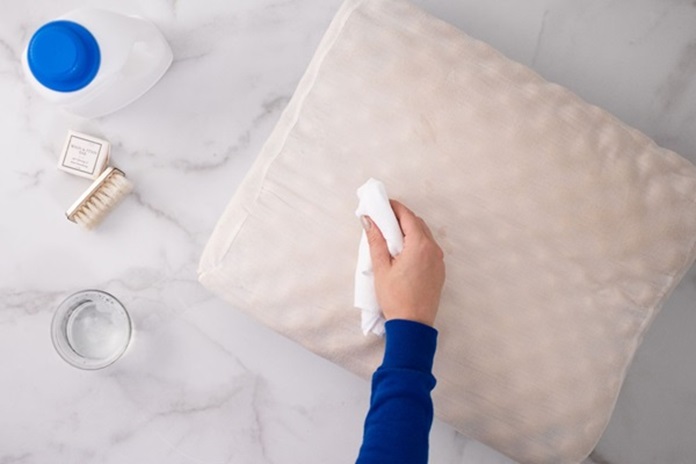Many pillows can’t be washed in a machine, especially feather and memory foam ones. You don’t want to go to the dry cleaner every time you spill something on them. Instead, you can learn to spot-clean your pillows at home to keep them clean without ruining them. Spot cleaning is an effective and easy way to tackle minor spills and stains on your pillows. In this article, we will show you how to spot-clean your pillows, preserving their quality and extending their lifespan. Whether your pillow is made of feathers, memory foam, or another material, you will be equipped with the knowledge to keep it looking and feeling its best. Let’s get started.
Lemon Juice
The acid in lemon juice acts as a natural bleaching agent, making it an excellent choice for spot-cleaning pillows. Here are two methods you can try:
Lemon Juice and Water Solution:
- Mix one part lemon juice with two parts warm water.
- Gently dab the stain with a white towel or damp sponge until the stain is removed.
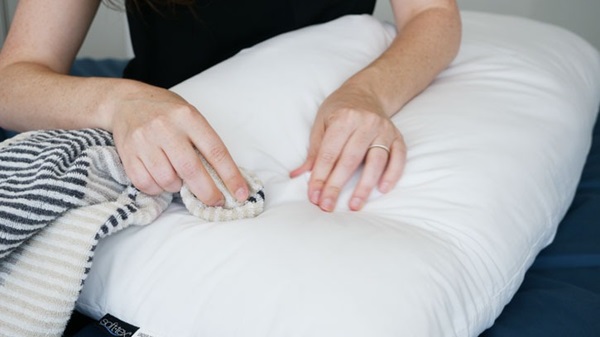
Lemon and Salt Method:
- Squeeze a lemon directly onto the stain.
- Sprinkle salt on top of the lemon juice.
- Blot the mixture with a cloth, repeating until the stain is gone.
- Rinse the area with water.
These methods can effectively remove stains while keeping your pillow fresh and clean.
Stain Removers
Many natural stain removers can effectively clean your pillow cover. However, it’s important to use them correctly, as improper use can worsen the stain or create a new one.
A useful tip is to angle your pillow in a way that allows you to rinse just the cover without soaking the filling.
By angling the pillow downward, you can let the water run off the cover and into the sink, avoiding the fill.
Also read, Top Four Best Mattresses Without Fiberglass for a Safe and Comfortable Sleep
Dish Soap
Grease stains can be effectively tackled with good grease-fighting dish soap like Dawn. Here’s how to do it:
- Squirt a little dish soap directly onto the grease stain.
- Blot the stain with a wet white cloth.
- For tough stains, leave the soap on the stain for a few hours.
- Rinse only the stained area with as little water as possible to remove the soap.
This method helps break down the grease and lifts the stain, keeping your pillow clean.
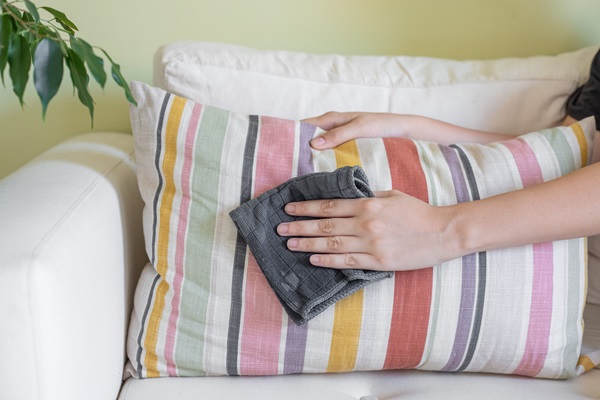
White Vinegar and Baking Soda
White vinegar, combined with baking soda, can effectively remove even tough, set-in stains. Here is how to use this powerful duo:
- Saturate the stain with white vinegar.
- Rub the stain with a paste made from equal parts white vinegar and baking soda.
- Rinse off all the paste after the stain is lifted.
This method helps break down and lift the stain, leaving your pillow cover clean and fresh.
Dry Vacuuming
For removing dust and dry dirt from your pillow, dry vacuuming is an effective method. Here is how to do it:
- Use a vacuum cleaner with an upholstery attachment.
- Thoroughly vacuum the pillow’s surface.
This can help lift brown or yellow marks caused by dirt and remove dust mites, keeping your pillow clean without using water.
Wet Vacuuming
Wet vacuuming is the best alternative for deep-cleaning pillows, particularly those with fills that should not get too wet. Here is how to do it:
- Use an upholstery vacuum with a sprayer attachment.
- Spray hot water or steam and upholstery shampoo onto the stain.
- Immediately suck up the moisture with the vacuum to avoid soaking the fill.
- Remove excess moisture and fluff your pillows after cleaning to ensure they dry completely.
Always check your pillow’s care label to make sure it can handle the heat from steam cleaning.
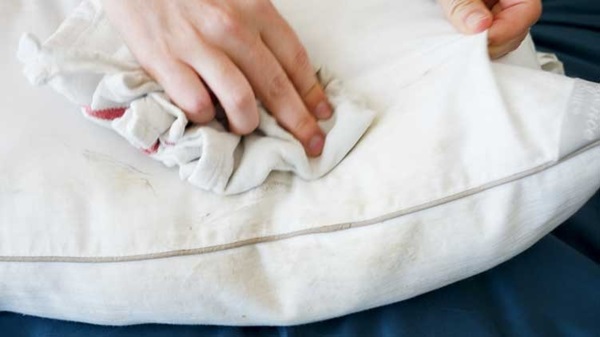
Upholstery Cleaners
Upholstery cleaners, also known as furniture vacuums, are effective for removing stubborn stains from your pillows. Here’s how to use them:
- Choose an upholstery cleaner designed for delicate fabrics.
- Follow the manufacturer’s instructions for applying the cleaner to the stain.
- Use the upholstery cleaner vacuum function to remove the cleaning solution and the stain.
These specialized cleaners can effectively tackle resistant stains, keeping your pillows looking fresh and clean.
What’s the pillow material with the easiest maintenance?
If you don’t want to bother with soot cleaning or dry cleaning, some pillows can be machine-washed. For instance, cotton and fiberfill pillows can be washed on a delicate cycle and dried on low or no heat.
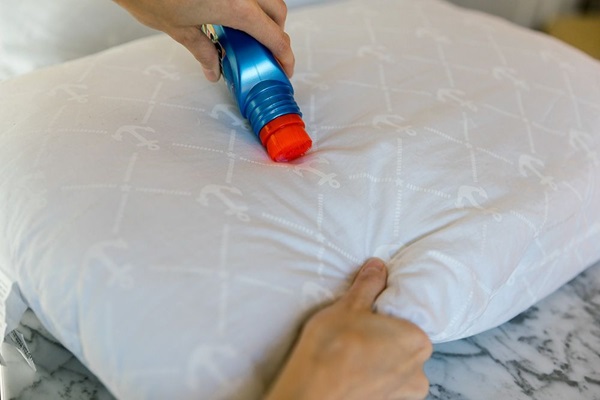
Down pillows can be washed in a bathtub or a washing machine without an agitator, but they should be dried in the no-heat setting or by laying them out. Avoid machine-washing feather and foam can soak up water, damaging its structure and causing mold or mildew.
Will a pillow protector help keep my pillow clean?
Pillow protectors are a great way to keep your pillows clean and in good condition. Unlike pillowcases, which are part of your sheet set and mainly serve to make your pillows look nice, pillow protectors offer more protection.
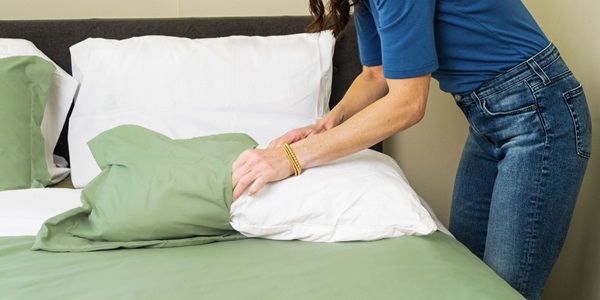
Moreover, Pillow protectors zip shut and can be waterproof, shielding your pillow from dust, sweat, and oil. If you use a pillow protector under your pillowcase, it helps keep your pillow clean and dry for a longer time.
Conclusion
In conclusion, maintaining the cleanliness of your pillows is essential for both hygiene and longevity. While machine washing is not always suitable for certain pillow materials like feathers and memory foam, spot-cleaning provides a practical and efficient alternative. Using natural solutions such as lemon juice, white vinegar, and baking soda can effectively remove stains and freshen your pillows.
For grease stains, dish soap works wonders, while vacuuming—either dry or wet—helps eliminate dust and deep-seated dirt. Additionally, upholstery cleaners offer a specialized approach for stubborn stains. To further protect your pillows, consider using pillow protectors, which offer an added layer of defense against dust, sweat, and oil. By employing these methods, you can ensure your pillows remain clean, comfortable, and in excellent condition for years to come.
Frequently Asked Question
Can I use bleach to clean pillow stains?
It is generally not recommended to use bleach on pillows as it can damage the fabric and affect the pillow’s fill. Stick to gentler cleaners like dish soap, vinegar, or lemon juice.
Are upholstery cleaners effective for pillow cleaning?
Yes, upholstery cleaners designed for delicate fabrics can effectively remove stubborn stains from pillows. Follow the manufacturer’s instructions for applying the cleaner and using the vacuum function to remove the cleaning solution and stain.
Which pillow materials are easiest to maintain?
Cotton and fiberfill pillows can be machine-washed on a delicate cycle and dried on low or no heat. Down pillows can also be washed in a bathtub or a washing machine without an agitator and dried on a no-heat setting or by laying them out.
What is wet vacuuming and when should it be used?
Wet vacuuming is used for deep-cleaning pillows, especially those with fills that should not get too wet. Use an upholstery vacuum with a sprayer attachment to spray hot water or steam and upholstery shampoo onto the stain, and then immediately suck up the moisture with the vacuum.
Are natural stain removers safe for pillow cleaning?
Yes, natural stain removers like lemon juice, white vinegar, and baking soda can effectively clean pillow covers. However, it is important to use them correctly to avoid worsening the stain or creating new ones.
How can I clean grease stains on my pillow?
Use grease-fighting dish soap, such as Dawn. Squirt a little dish soap directly onto the grease stain, blot it with a wet white cloth, leave the soap on tough stains for a few hours, and rinse the stained area with as little water as possible.
You may also like to read, Know Everything About King Size Bed Frame Measurements
